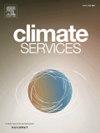热健康风险网格尺度评价框架——以京津冀地区为例
IF 4.5
3区 环境科学与生态学
Q2 ENVIRONMENTAL SCIENCES
引用次数: 0
摘要
极端高温事件日益频繁,造成了严重和广泛的全球影响。综合热风险评估对于提供有针对性的气候信息和服务以增强城市适应和减缓能力至关重要。然而,行政层面的热健康风险评估的空间分辨率不足以识别城市内部的风险变化。本研究建立了一个综合危害、暴露、易感性和适应性因素的热相关健康风险评估框架。利用缩小尺度的地表温度、网格化的社会经济数据和兴趣点数据等地理空间数据,在500米网格分辨率下对京津冀地区的热健康风险进行了综合评估。结果表明,北京和天津主要城区为高危区;局部气候带(LCZ)分类分析揭示了不同城市形态的不同热风险模式。紧凑高层建成区(lcz1)的平均热危害指数最高(0.82),自然型lczb区最低(0.48)。LCZ 1(0.68)和LCZ 2(0.67)的热风险最高,LCZ 4(0.60)和LCZ 5(0.57)次之。为降低热风险,应优先在lccs 1和2区域实施降低环境温度和人口密度的措施,而lccs 3、4和5区域应优先加强医疗和交通基础设施。这些精细规模的风险评估方法有效地捕捉了地方规模的风险热点,为改善热治理实践和建设更具热弹性的城市提供了可操作的见解。本文章由计算机程序翻译,如有差异,请以英文原文为准。
A grid-scale assessment framework for heat health risks: A case study of the Beijing-Tianjin-Hebei Region, China
The increasing frequency of extreme heat events has resulted in severe and widespread global impacts. Comprehensive heat risk assessment is crucial for providing targeted climate information and services to enhance cities’ adaptation and mitigation capacities. However, the spatial resolution of administrative-level heat health risk assessments is inadequate for identifying intra-urban risk variations. This study developed a risk assessment framework for heat-related health risks integrating hazard, exposure, susceptibility, and adaptability factors. Utilizing geospatial data such as downscaled land surface temperature, gridded socioeconomic data and point of interest data, the heat health risks were evaluated comprehensively at a fine-grained 500-meter grid resolution in the Beijing-Tianjin-Hebei region, China. The results indicated that high-risk profiles were concentrated in the primary urban areas of Beijing and Tianjin. Analysis of Local Climate Zone (LCZ) classifications revealed distinct heat risk patterns across urban morphologies. Compact high-rise built zones (LCZ 1) showed the highest mean heat hazard index (0.82), while natural-type LCZ B areas exhibited the lowest (0.48). LCZ 1 (0.68) and LCZ 2 (0.67) represented the highest heat risk, followed by LCZ 4 (0.60) and LCZ 5 (0.57). To mitigate heat risks, priority measures for reducing ambient temperature and population density should be implemented in LCZs 1 and 2 regions, while LCZs 3, 4, and 5 should prioritize enhancements to healthcare and transportation infrastructure. These fine-scale risk assessment approaches effectively capture local-scale risk hotspots, providing actionable insights for improving heat governance practices and building more thermally resilient cities.
求助全文
通过发布文献求助,成功后即可免费获取论文全文。
去求助
来源期刊

Climate Services
Multiple-
CiteScore
5.30
自引率
15.60%
发文量
62
期刊介绍:
The journal Climate Services publishes research with a focus on science-based and user-specific climate information underpinning climate services, ultimately to assist society to adapt to climate change. Climate Services brings science and practice closer together. The journal addresses both researchers in the field of climate service research, and stakeholders and practitioners interested in or already applying climate services. It serves as a means of communication, dialogue and exchange between researchers and stakeholders. Climate services pioneers novel research areas that directly refer to how climate information can be applied in methodologies and tools for adaptation to climate change. It publishes best practice examples, case studies as well as theories, methods and data analysis with a clear connection to climate services. The focus of the published work is often multi-disciplinary, case-specific, tailored to specific sectors and strongly application-oriented. To offer a suitable outlet for such studies, Climate Services journal introduced a new section in the research article type. The research article contains a classical scientific part as well as a section with easily understandable practical implications for policy makers and practitioners. The journal''s focus is on the use and usability of climate information for adaptation purposes underpinning climate services.
 求助内容:
求助内容: 应助结果提醒方式:
应助结果提醒方式:


